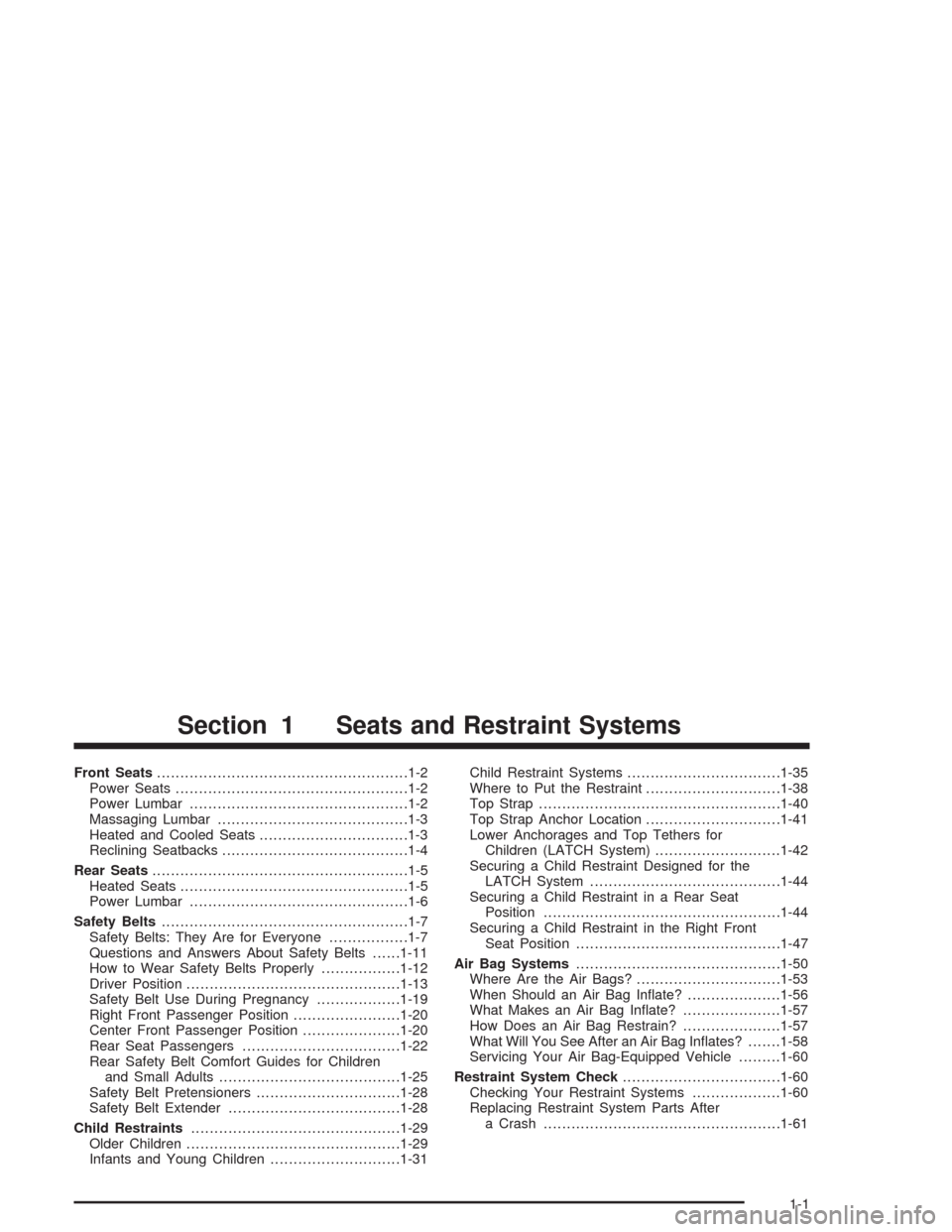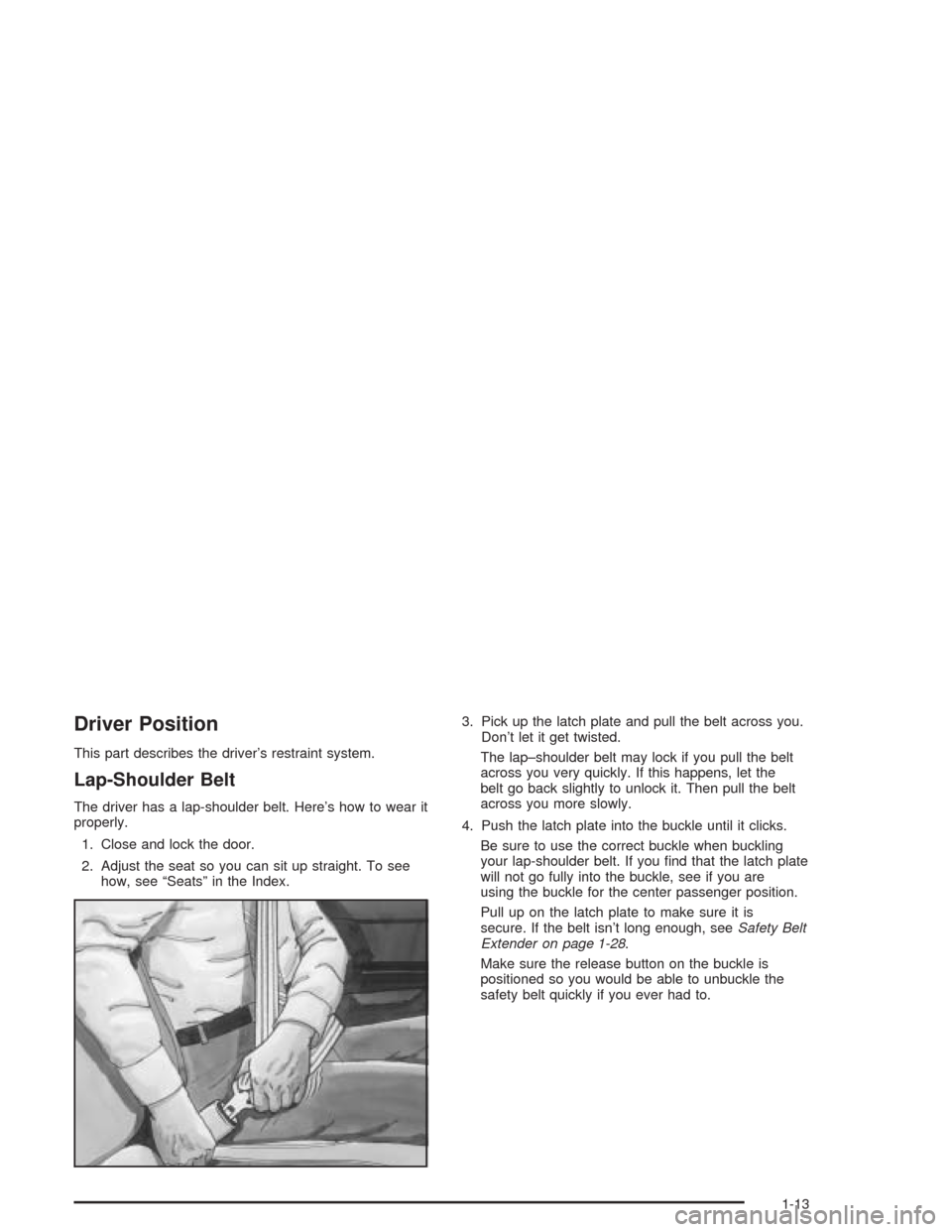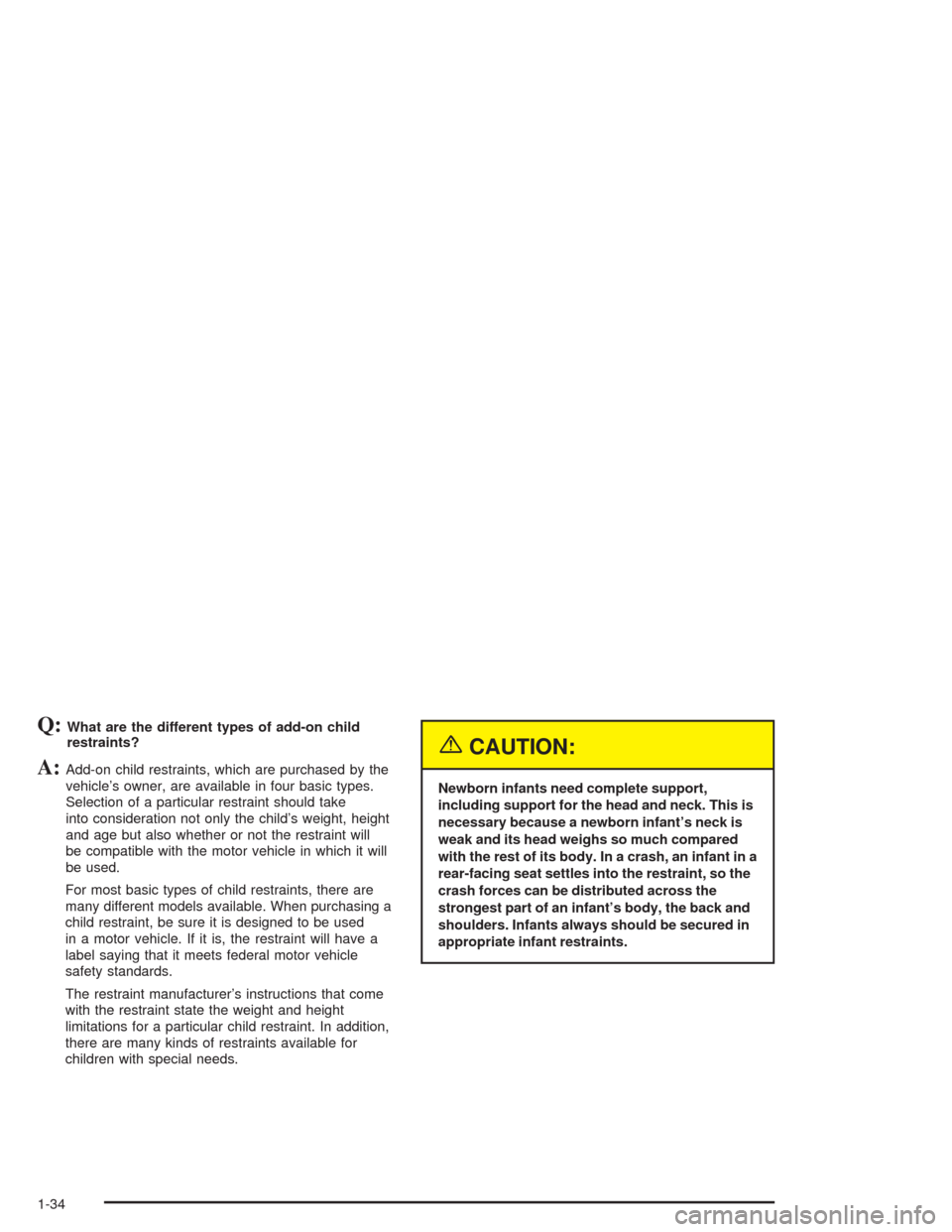ECU CADILLAC DEVILLE 2004 8.G Owners Manual
[x] Cancel search | Manufacturer: CADILLAC, Model Year: 2004, Model line: DEVILLE, Model: CADILLAC DEVILLE 2004 8.GPages: 460, PDF Size: 2.88 MB
Page 7 of 460

Front Seats......................................................1-2
Power Seats..................................................1-2
Power Lumbar...............................................1-2
Massaging Lumbar.........................................1-3
Heated and Cooled Seats................................1-3
Reclining Seatbacks........................................1-4
Rear Seats.......................................................1-5
Heated Seats.................................................1-5
Power Lumbar...............................................1-6
Safety Belts.....................................................1-7
Safety Belts: They Are for Everyone.................1-7
Questions and Answers About Safety Belts......1-11
How to Wear Safety Belts Properly.................1-12
Driver Position..............................................1-13
Safety Belt Use During Pregnancy..................1-19
Right Front Passenger Position.......................1-20
Center Front Passenger Position.....................1-20
Rear Seat Passengers..................................1-22
Rear Safety Belt Comfort Guides for Children
and Small Adults.......................................1-25
Safety Belt Pretensioners...............................1-28
Safety Belt Extender.....................................1-28
Child Restraints.............................................1-29
Older Children..............................................1-29
Infants and Young Children............................1-31Child Restraint Systems.................................1-35
Where to Put the Restraint.............................1-38
Top Strap....................................................1-40
Top Strap Anchor Location.............................1-41
Lower Anchorages and Top Tethers for
Children (LATCH System)...........................1-42
Securing a Child Restraint Designed for the
LATCH System.........................................1-44
Securing a Child Restraint in a Rear Seat
Position...................................................1-44
Securing a Child Restraint in the Right Front
Seat Position............................................1-47
Air Bag Systems............................................1-50
Where Are the Air Bags?...............................1-53
When Should an Air Bag In�ate?....................1-56
What Makes an Air Bag In�ate?.....................1-57
How Does an Air Bag Restrain?.....................1-57
What Will You See After an Air Bag In�ates?.......1-58
Servicing Your Air Bag-Equipped Vehicle.........1-60
Restraint System Check..................................1-60
Checking Your Restraint Systems...................1-60
Replacing Restraint System Parts After
a Crash...................................................1-61
Section 1 Seats and Restraint Systems
1-1
Page 19 of 460

Driver Position
This part describes the driver’s restraint system.
Lap-Shoulder Belt
The driver has a lap-shoulder belt. Here’s how to wear it
properly.
1. Close and lock the door.
2. Adjust the seat so you can sit up straight. To see
how, see “Seats” in the Index.3. Pick up the latch plate and pull the belt across you.
Don’t let it get twisted.
The lap–shoulder belt may lock if you pull the belt
across you very quickly. If this happens, let the
belt go back slightly to unlock it. Then pull the belt
across you more slowly.
4. Push the latch plate into the buckle until it clicks.
Be sure to use the correct buckle when buckling
your lap-shoulder belt. If you �nd that the latch plate
will not go fully into the buckle, see if you are
using the buckle for the center passenger position.
Pull up on the latch plate to make sure it is
secure. If the belt isn’t long enough, seeSafety Belt
Extender on page 1-28.
Make sure the release button on the buckle is
positioned so you would be able to unbuckle the
safety belt quickly if you ever had to.
1-13
Page 29 of 460

2. Push the latch plate into the buckle until it clicks.
The latch plates for the safety belts in each rear
seating position vary in size. If the center rear or the
left rear latch plate is inserted into the incorrect
buckle, the plate will not latch properly. Be sure you
are using the correct buckle and that the latch
plate clicks when inserted into the buckle.
If the belt stops before it reaches the buckle, tilt the
latch plate and keep pulling until you can buckle it.
Pull up on the latch plate to make sure it is secure.If the belt is not long enough, seeSafety Belt
Extender on page 1-28.
Make sure the release button on the buckle is
positioned so you would be able to unbuckle the
safety belt quickly if you ever had to.
3. To make the lap part tight, pull down on the buckle
end of the belt as you pull up on the shoulder part.
1-23
Page 38 of 460

Every time infants and young children ride in vehicles,
they should have the protection provided by appropriate
restraints. Young children should not use the vehicle’s
adult safety belts alone, unless there is no other choice.
Instead, they need to use a child restraint.
{CAUTION:
People should never hold a baby in their arms
while riding in a vehicle. A baby does not
weigh much -- until a crash. During a crash a
baby will become so heavy it is not possible to
hold it. For example, in a crash at only 25 mph
(40 km/h), a 12-lb. (5.5 kg) baby will suddenly
become a 240-lb. (110 kg) force on a person’s
arms. A baby should be secured in an
appropriate restraint.
1-32
Page 40 of 460

Q:What are the different types of add-on child
restraints?
A:Add-on child restraints, which are purchased by the
vehicle’s owner, are available in four basic types.
Selection of a particular restraint should take
into consideration not only the child’s weight, height
and age but also whether or not the restraint will
be compatible with the motor vehicle in which it will
be used.
For most basic types of child restraints, there are
many different models available. When purchasing a
child restraint, be sure it is designed to be used
in a motor vehicle. If it is, the restraint will have a
label saying that it meets federal motor vehicle
safety standards.
The restraint manufacturer’s instructions that come
with the restraint state the weight and height
limitations for a particular child restraint. In addition,
there are many kinds of restraints available for
children with special needs.
{CAUTION:
Newborn infants need complete support,
including support for the head and neck. This is
necessary because a newborn infant’s neck is
weak and its head weighs so much compared
with the rest of its body. In a crash, an infant in a
rear-facing seat settles into the restraint, so the
crash forces can be distributed across the
strongest part of an infant’s body, the back and
shoulders. Infants always should be secured in
appropriate infant restraints.
1-34
Page 41 of 460

{CAUTION:
The body structure of a young child is quite
unlike that of an adult or older child, for whom
the safety belts are designed. A young child’s
hip bones are still so small that the vehicle’s
regular safety belt may not remain low on the
hip bones, as it should. Instead, it may settle
up around the child’s abdomen. In a crash, the
belt would apply force on a body area that is
unprotected by any bony structure. This alone
could cause serious or fatal injuries. Young
children always should be secured in
appropriate child restraints.
Child Restraint Systems
An infant car bed (A), a special bed made for use in a
motor vehicle, is an infant restraint system designed
to restrain or position a child on a continuous �at
surface. Make sure that the infant’s head rests toward
the center of the vehicle.
1-35
Page 43 of 460

A booster seat (F-G) is a child restraint designed to
improve the �t of the vehicle’s safety belt system. Some
booster seats have a shoulder belt positioner, and some
high-back booster seats have a �ve-point harness. A
booster seat can also help a child to see out the window.
Q:How do child restraints work?
A:A child restraint system is any device designed for
use in a motor vehicle to restrain, seat, or position
children. A built-in child restraint system is a
permanent part of the motor vehicle. An add-on
child restraint system is a portable one, which
is purchased by the vehicle’s owner.
For many years, add-on child restraints have used
the adult belt system in the vehicle. To help
reduce the chance of injury, the child also has to be
secured within the restraint. The vehicle’s belt
system secures the add-on child restraint in the
vehicle, and the add-on child restraint’s harness
system holds the child in place within the restraint.
One system, the three-point harness, has straps that
come down over each of the infant’s shoulders and
buckle together at the crotch. The �ve-point harness
system has two shoulder straps, two hip straps and a
crotch strap. A shield may take the place of hip
straps. A T-shaped shield has shoulder straps that
are attached to a �at pad which rests low against the
child’s body. A shelf- or armrest-type shield has
straps that are attached to a wide, shelf-like shield
that swings up or to the side.
1-37
Page 44 of 460

When choosing a child restraint, be sure the child
restraint is designed to be used in a vehicle. If it is, it
will have a label saying that it meets federal motor
vehicle safety standards.
Then follow the instructions for the restraint. You may
�nd these instructions on the restraint itself or in a
booklet, or both. These restraints use the belt system or
the LATCH system in your vehicle, but the child also
has to be secured within the restraint to help reduce the
chance of personal injury. When securing an add-on
child restraint, refer to the instructions that come with the
restraint which may be on the restraint itself or in a
booklet, or both, and to this manual. The child restraint
instructions are important, so if they are not available,
obtain a replacement copy from the manufacturer.Where to Put the Restraint
Accident statistics show that children are safer if they are
restrained in the rear rather than the front seat. We,
therefore, recommend that child restraints be secured in
a rear seat, including an infant riding in a rear-facing
infant seat, a child riding in a forward-facing child seat
and an older child riding in a booster seat.Neverput a
rear-facing child restraint in the front passenger seat.
1-38
Page 45 of 460

Here is why:
{CAUTION:
A child in a rear-facing child restraint can be
seriously injured or killed if the right front
passenger’s air bag in�ates. This is because
the back of the rear-facing child restraint
would be very close to the in�ating air bag.
Always secure a rear-facing child restraint in a
rear seat.
If you secure a forward-facing child restraint in
the right front seat, always move the front
passenger seat as far back as it will go. It is
better to secure the child restraint in a rear seat.
{CAUTION:
A child in a child restraint in the center front
seat can be badly injured or killed by the right
front passenger’s air bag if it in�ates. Never
secure a child restraint in the center front seat.
It is always better to secure a child restraint in
the rear seat.
If you secure a forward-facing child restraint in
the right front passenger seat, always move
the front passenger seat as far back as it will
go. It is better to secure the child restraint in a
rear seat.
Wherever you install it, be sure to secure the child
restraint properly.
Keep in mind that an unsecured child restraint can
move around in a collision or sudden stop and injure
people in the vehicle. Be sure to properly secure
any child restraint in your vehicle – even when no child
is in it.
1-39
Page 47 of 460

Anchor the top strap to one of the following anchor
points. Be sure to use an anchor point located on the
same side of the vehicle as the seating position
where the child restraint will be placed.
If you have an adjustable head restraint, route the top
strap under it.
{CAUTION:
Each top tether bracket is designed to anchor
only one child restraint. Attaching more than
one child restraint to a single bracket could
cause the anchor to come loose or even break
during a crash. A child or others could be
injured if this happens. To help prevent injury
to people and damage to your vehicle, attach
only one child restraint per bracket.
Once you have the top strap anchored, you will be
ready to secure the child restraint itself. Tighten the top
strap when and as the child restraint manufacturer’s
instructions say.
Top Strap Anchor Location
Your vehicle has top strap anchors already installed for
the rear seating positions. You will �nd them behind
the rear seat on the �ller panel.
In order to get to a bracket, you will have to open the
trim cover.
Do not use a child restraint with a top strap in the right
front passenger’s position because there is no place
to anchor the top strap.
1-41